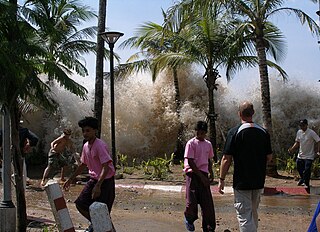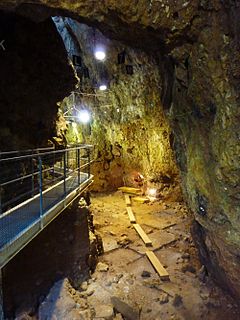
The Cenozoic is Earth's current geological era, representing the last 66 million years of Earth's history. It is characterized by the dominance of mammals, birds and flowering plants, a cooling and drying climate, and the current configuration of continents. It is the latest of three geological eras since complex life evolved, preceded by the Mesozoic and Paleozoic. It started with the Cretaceous–Paleogene extinction event, when many species, including the non-avian dinosaurs, became extinct in an event attributed by most experts to the impact of a large asteroid or other celestial body, the Chicxulub impactor.

The Mediterranean Sea is a sea connected to the Atlantic Ocean, surrounded by the Mediterranean Basin and almost completely enclosed by land: on the north by Western and Southern Europe and Anatolia, on the south by North Africa, and on the east by the Levant. The Sea has played a central role in the history of Western civilization. Although the Mediterranean is sometimes considered a part of the Atlantic Ocean, it is usually referred to as a separate body of water. Geological evidence indicates that around 5.9 million years ago, the Mediterranean was cut off from the Atlantic and was partly or completely desiccated over a period of some 600,000 years during the Messinian salinity crisis before being refilled by the Zanclean flood about 5.3 million years ago.

A tsunami is a series of waves in a water body caused by the displacement of a large volume of water, generally in an ocean or a large lake. Earthquakes, volcanic eruptions and other underwater explosions above or below water all have the potential to generate a tsunami. Unlike normal ocean waves, which are generated by wind, or tides, which are generated by the gravitational pull of the Moon and the Sun, a tsunami is generated by the displacement of water by a large event.

An impact event is a collision between astronomical objects causing measurable effects. Impact events have physical consequences and have been found to regularly occur in planetary systems, though the most frequent involve asteroids, comets or meteoroids and have minimal effect. When large objects impact terrestrial planets such as the Earth, there can be significant physical and biospheric consequences, though atmospheres mitigate many surface impacts through atmospheric entry. Impact craters and structures are dominant landforms on many of the Solar System's solid objects and present the strongest empirical evidence for their frequency and scale.

A megatsunami is a very large wave created by a large, sudden displacement of material into a body of water.
An impact winter is a hypothesized period of prolonged cold weather due to the impact of a large asteroid or comet on the Earth's surface. If an asteroid were to strike land or a shallow body of water, it would eject an enormous amount of dust, ash, and other material into the atmosphere, blocking the radiation from the Sun. This would cause the global temperature to decrease drastically. If an asteroid or comet with the diameter of about 5 km (3.1 mi) or more were to hit in a large deep body of water or explode before hitting the surface, there would still be an enormous amount of debris ejected into the atmosphere. It has been proposed that an impact winter could lead to mass extinction, wiping out many of the world's existing species. The Cretaceous–Paleogene extinction event probably involved an impact winter, and led to mass extinction of most tetrapods weighing more than 25 kilograms.
A hypercane is a hypothetical class of extreme tropical cyclone that could form if sea surface temperatures reached approximately 50 °C (122 °F), which is 15 °C (27 °F) warmer than the warmest ocean temperature ever recorded. Such an increase could be caused by a large asteroid or comet impact, a large supervolcanic eruption, a large submarine flood basalt, or extensive global warming. There is some speculation that a series of hypercanes resulting from the impact of a large asteroid or comet contributed to the demise of the non-avian dinosaurs. The hypothesis was created by Kerry Emanuel of MIT, who also coined the term. Additionally, it is also speculated that many planets that could orbit red dwarf stars, if they have liquid water, would permanently experience hypercanes on their sunlit faces due to the effects of tidal locking. This could potentially challenge any life forms that were to live there.

Ponza is the largest island of the Italian Pontine Islands archipelago, located 33 km (21 mi) south of Cape Circeo in the Tyrrhenian Sea. It is also the name of the commune of the island, a part of the province of Latina in the Lazio region.

The Nile Delta is the delta formed in Lower Egypt where the Nile River spreads out and drains into the Mediterranean Sea. It is one of the world's largest river deltas—from Alexandria in the west to Port Said in the east, it covers 240 km (150 mi) of Mediterranean coastline and is a rich agricultural region. From north to south the delta is approximately 160 km (99 mi) in length. The Delta begins slightly down-river from Cairo.

Pleistocene megafauna is the set of large animals that lived on Earth during the Pleistocene epoch and became extinct during the Quaternary extinction event. Megafauna are any animals with an adult body weight of over 45 kilograms (99 lb).

The Alvarez hypothesis posits that the mass extinction of the non-avian dinosaurs and many other living things during the Cretaceous–Paleogene extinction event was caused by the impact of a large asteroid on the Earth. Prior to 2013, it was commonly cited as having happened about 65 million years ago, but Renne and colleagues (2013) gave an updated value of 66 million years. Evidence indicates that the asteroid fell in the Yucatán Peninsula, at Chicxulub, Mexico. The hypothesis is named after the father-and-son team of scientists Luis and Walter Alvarez, who first suggested it in 1980. Shortly afterwards, and independently, the same was suggested by Dutch paleontologist Jan Smit.

The Grotte du Lazaret is an archaeological cave site of prehistoric human occupation study, situated in the eastern suburbs of the French town of Nice, overlooking the Mediterranean Sea. Results of excavations have been interpreted as to account for the construction of shelters by humans during the Lower Paleolithic period. Research teams have unearthed more than 20,000 fossilized faunal bone fragments.

Meltwater pulse 1A (MWP1a) is the name used by Quaternary geologists, paleoclimatologists, and oceanographers for a period of rapid post-glacial sea level rise, between 13,500 and 14,700 years ago, during which global sea level rose between 16 meters (52 ft) and 25 meters (82 ft) in about 400–500 years, giving mean rates of roughly 40–60 mm (0.13–0.20 ft)/yr. Meltwater pulse 1A is also known as catastrophic rise event 1 (CRE1) in the Caribbean Sea. The rates of sea level rise associated with meltwater pulse 1A are the highest known rates of post-glacial, eustatic sea level rise. Meltwater pulse 1A is also the most widely recognized and least disputed of the named, postglacial meltwater pulses. Other named, postglacial meltwater pulses are known most commonly as meltwater pulse 1A0, meltwater pulse 1B, meltwater pulse 1C, meltwater pulse 1D, and meltwater pulse 2. It and these other periods of rapid sea level rise are known as meltwater pulses because the inferred cause of them was the rapid release of meltwater into the oceans from the collapse of continental ice sheets.
Phaeton was the hypothetical planet hypothesized by the Titius–Bode law to have existed between the orbits of Mars and Jupiter, the destruction of which supposedly led to the formation of the asteroid belt. The hypothetical planet was named for Phaethon, the son of the sun god Helios in Greek mythology, who attempted to drive his father's solar chariot for a day with disastrous results and was ultimately destroyed by Zeus. However, his name was used historically for Jupiter itself as well.

A marine regression is a geological process occurring when areas of submerged seafloor are exposed above the sea level. The opposite event, marine transgression, occurs when flooding from the sea covers previously-exposed land.

Europe: A Natural History is a four-part BBC nature documentary series which looks at the events which have shaped the natural history and wildlife of the European continent over the past three billion years. It debuted on UK television on BBC Four in February 2005, and was repeated on BBC Two in September the same year. The series was broadcast in some other territories as Wild Europe.

Mega Shark Versus Giant Octopus is a 2009 American-British monster disaster film distributed by The Asylum, released on May 19, 2009, in the United States and on August 7, 2009, in the United Kingdom. It was directed by Ace Hannah and stars singer Deborah Gibson and actor Lorenzo Lamas. The film is about the hunt for two prehistoric sea-monsters causing mayhem and carnage at sea, and is the first installment in the Mega Shark series of films.

The Late Heavy Bombardment (LHB), or lunar cataclysm, is a hypothesized event thought to have occurred approximately 4.1 to 3.8 billion years (Ga) ago, at a time corresponding to the Neohadean and Eoarchean eras on Earth. According to the hypothesis, during this interval, a disproportionately large number of asteroids collided with the early terrestrial planets in the inner Solar System, including Mercury, Venus, Earth and Mars. These came from both post-accretion and planetary instability-driven populations of impactors. Although generally accepted, it remains difficult to prove conclusively.

The Cretaceous–Paleogene (K–Pg) extinction event was a sudden mass extinction of three-quarters of the plant and animal species on Earth, approximately 66 million years ago. With the exception of some ectothermic species such as sea turtles and crocodilians, no tetrapods weighing more than 25 kilograms survived. It marked the end of the Cretaceous period, and with it the Mesozoic Era, while heralding the beginning of the Cenozoic Era, which continues to this day.
Meltwater pulse 1B (MWP1b) is the name used by Quaternary geologists, paleoclimatologists, and oceanographers for a period of either rapid or just accelerated post-glacial sea level rise that some hypothesize to have occurred between 11,500 and 11,200 years ago at the beginning of the Holocene and after the end of the Younger Dryas. Meltwater pulse 1B is also known as catastrophic rise event 2 (CRE2) in the Caribbean Sea.














